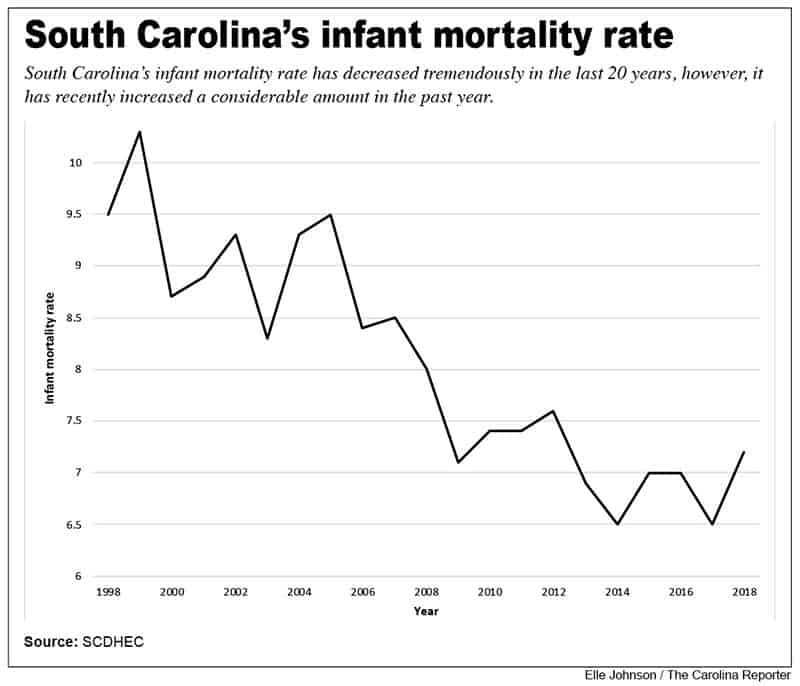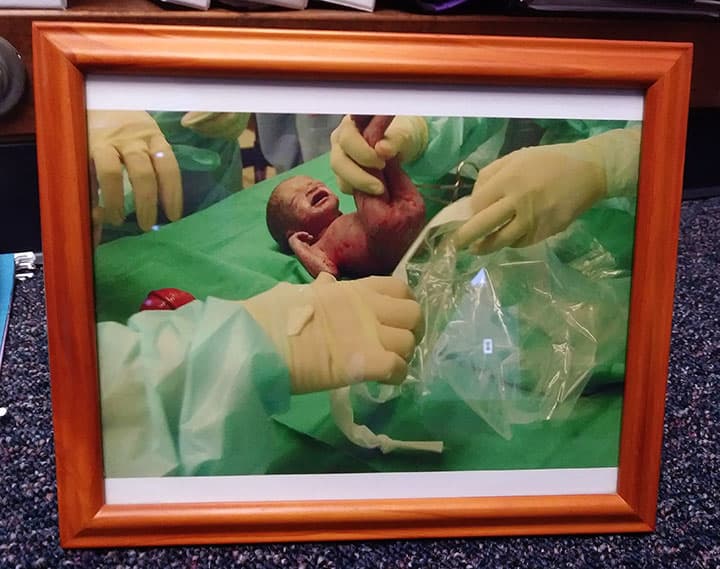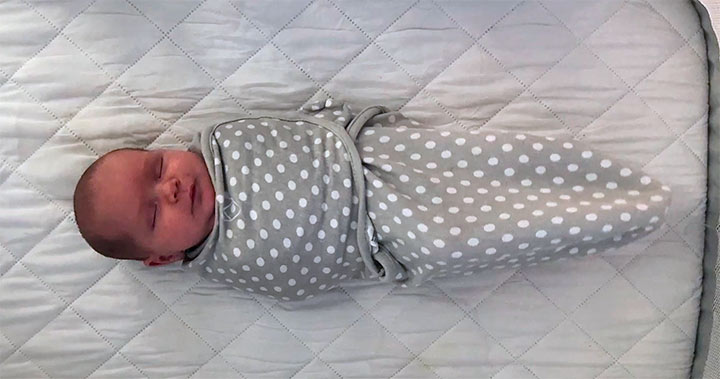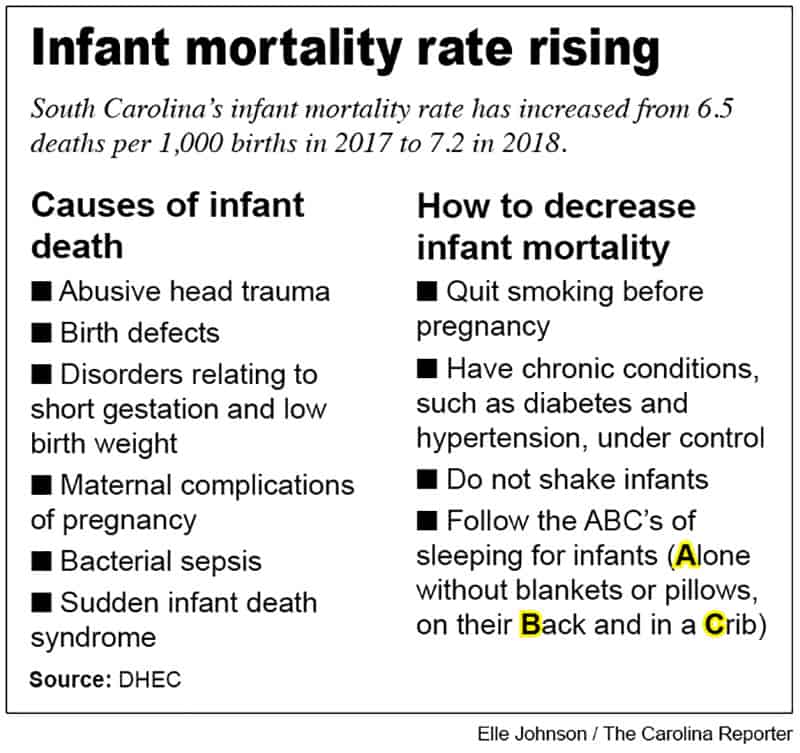Credit: DHEC
Infant mortality rate in South Carolina has risen by nearly 1% from 2017 to 2018, a recent report from the S.C. Department of Health and Environmental Control shows. While this may appear to be a small number, it’s a large change.
“South Carolina’s infant mortality rate increased to 7.2 deaths per 1,000 births. In 2017, the state’s infant mortality rate was 6.5 deaths per 1,000 births,” said Nick Davidson, DHEC’s interim director of Public Health.
Over the past two decades, it has decreased by over 30%. Normally, if infant mortality rate does rise, it’s by 0.1% or 0.2%, not 1%.
Dr. Robin Dail, associate dean of Faculty Affairs in the College of Nursing at the University of South Carolina, has conducted extensive research on premature babies to help lower infant mortality and morbidity. Dail’s research focuses on the thermal physiology of infants.
“Premature babies can’t manufacture their own heat, because they just don’t have the physiological mechanisms,” Dail said. “Babies up to 12 months old don’t have the ability to shiver like we do.”
Thermal physiology studies body temperature and Dail specifically looks at temperatures of the feet and abdomen.
Researching the difference in temperature between a baby’s feet and abdomen can determine if an infant is hypothermic and help predict if a premature infant is catching a life-threatening infection. This allows doctors to treat the infant before the infection leads to a potentially fatal complication, such as bacterial sepsis.
Dail said hypothermia in infants is correlated with “severe brain hemorrhage, which can also lead to mortality and has been found to be linked with sepsis.”
One way doctors treat hypothermia in premature infants is by wrapping them in a sterile plastic bag.
“It was designed to make them warmer when we brought them to the NICU from the delivery room,” Dail said. “It shields in the warmth and doesn’t let it escape outside the bag.”
Dail was among the first researchers to wrap premature infants in sterile plastic bags. Now, it’s standard procedure in hospitals worldwide for babies under 29 weeks gestation.
The thermal physiology of a premature infant is only one cause of mortality.
“Prematurity in itself increases mortality, so we have to figure out a way to decrease prematurity,” Dail said. “Things that cause prematurity are lack of prenatal care, drug abuse, especially crack or cocaine, and there’s people that just have premature babies and they don’t really know why.”
According to the Centers for Disease Control, prematurity accounts for 17% of infant deaths and complications resulting from prematurity are the leading cause of infant mortality.
Davidson said the other three most common causes of infant deaths are birth defects, accidents and maternal complications.
In a report from DHEC, Kimberly Seals, director of DHEC’s Bureau of Maternal and Child Health, said, “While some risk factors for infant mortality are related to access to care, there are many practical steps that women can take before and during a pregnancy, as well as things that caregivers can do after a baby’s birth to help prevent some types of infant deaths.”
Dail said many premature births can be prevented before a pregnancy. Preterms related to maternal complications, such as the mother not receiving the care she needs or the mother abusing drugs, can be prevented. This can also prevent some birth defects.
Expectant mothers should quit smoking, get chronic conditions such as diabetes and hypertension under control and take multivitamins, according to a report from DHEC.
Accidental deaths can also be prevented.
The most common form of accidental deaths in infants are sleep related. Sleep-related deaths can be reduced by 50% if the infant’s crib is in the parent’s room. Seals said these deaths can also be prevented with the ABC’s of sleeping for infants.
“Leave your baby alone on their back in their crib without blankets, pillows or bumper pads,” Seals said.
Decreasing infant mortality in the U.S. is only one part of the equation. Dial hopes to expand her research and knowledge to third world countries to give those infants the care they need.
“Through improving infant temperature, we’re trying to expand our work into other countries to reduce infant mortality worldwide.”
Dr. Robin Dail, associate dean for faculty affairs at UofSC’s College of Nursing, researches thermal physiology in premature babies in an effort to decrease infant mortality. Dail monitors the body temperature in premature infants as a way to detect life-threatening infections.
Dail was among the first researchers to wrap a sterile plastic bag around premature babies to keep them warm. This method is now standard procedure in hospitals all over the U.S. to prevent hypothermia in infants.
The South Carolina Department of Health and Environmental Control encourages the ABC’s of sleeping for infants. Let the infant sleep alone in their crib. Always lay the infant on their back and in a crib without toys, pillows or blankets. Credit: DHEC
Check crib labels to be sure it is safe for a baby to sleep in. Cribs that are made after 2011 and are approved by the Consumer Product Safety Commission are safe for infants to sleep in. Credit: DHEC








